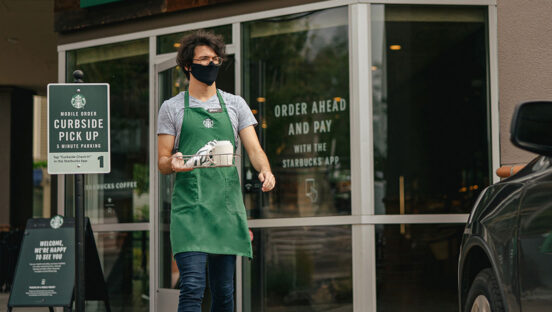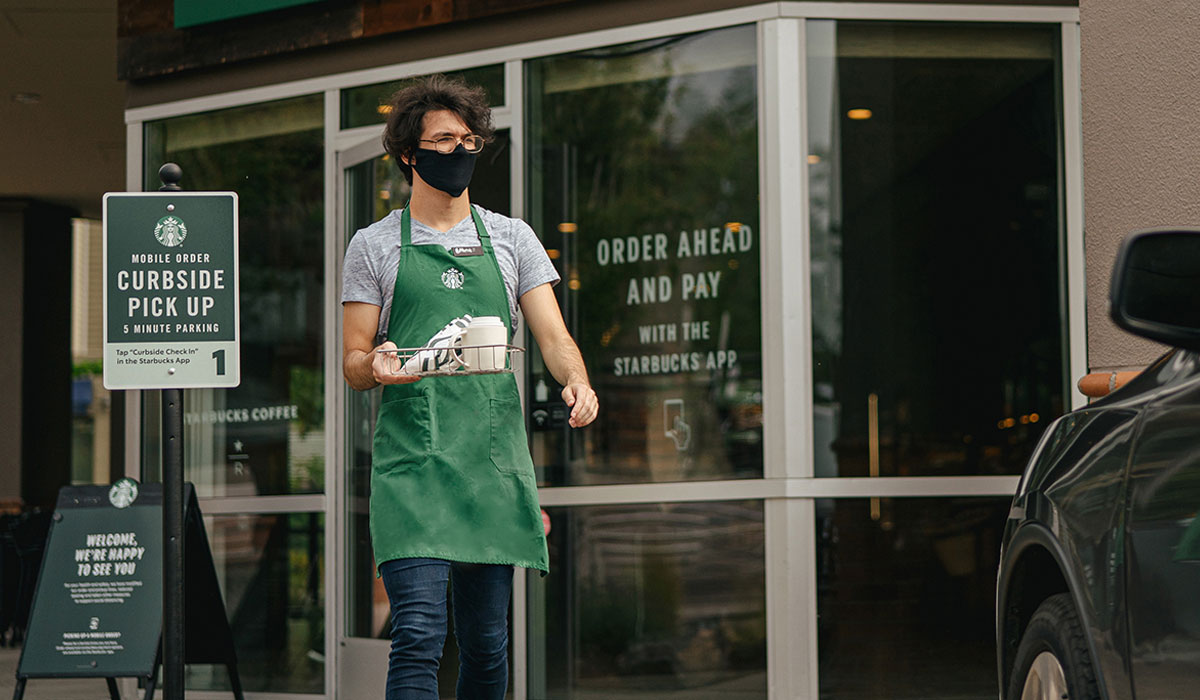Starbucks and Chipotle both decided to remove mask mandates for customers, signaling what could become a significant shift for the restaurant industry.
For Starbucks company-operated stores, facial coverings became optional for vaccinated customers on Monday, unless local regulations require them. However, employees are still required to wear a mask, and restrooms generally remain temporarily closed in stores where the café or café seating is closed. Chipotle echoed the same message in its updated COVID guidelines. Both quick-service chains had customer mask mandates in place since July, a time when the U.S. went through a debilitating COVID spike.
The significant switch comes after the CDC released new guidelines that said “fully vaccinated people no longer need to wear a mask or physically distance in any setting, except where required by federal, state, local, tribal, or territorial laws, rules, and regulations, including local business and workplace guidance.” In response, several big retailers like Walmart, Target, CVS, Costco, and Trader Joe’s have pulled back their mask mandates. In some cases, like Walmart and Target, employees don’t have to wear masks either if they are fully vaccinated.
Nearly 60 percent of states have removed statewide mask mandates. New York said it will remove its mask requirement for fully vaccinated individuals on Wednesday while California will wait until June 15, the date it’s supposed to fully reopen its economy. As of Monday morning, 157.8 million Americans have received at least one dose, or 47.5 percent of the total population, while 123.8 million are fully vaccinated, or 37.3 percent of the total population. On Monday, the CDC reported a seven-day moving average of 30,211 COVID cases—numbers the U.S. hasn’t seen since late June 2020. Additionally, the seven-day moving average for deaths was 545, which is comparable to April 2020.
Meanwhile, the National Restaurant Association is in the midst of changing its guidance to reflect the latest news from the CDC.
“We still have a lot of questions for the CDC about how we need to implement their latest guidance,” said Larry Lynch, senior vice president of science and industry, in a statement. “We are in the process of updating our COVID-19 Operating Guidance where it reflects the CDC’s previous language and after talking with CDC, will determine if other changes are needed.”
“The announcement by the CDC that fully vaccinated people no longer need to wear masks indoors or outdoors means that restaurant operators have the option of determining how best to enforce the new guidance,” Lynch added. “Because restaurants welcome people who are both vaccinated and not fully vaccinated, operators will still need to work with their state and local regulators to ensure they are in line with all other mandates in place. … The restaurant industry has always placed a focus on the health and safety of our workforce and our customers, so we are encouraged by the CDC’s decision and the potential it has to help move the restaurant industry closer to being fully reopened in all communities where the virus is not an immediate threat.”
While a positive sign restaurants are headed further toward recovery, the CDC’s ruling does create some near-term confusion for operators.
Rebecca Bernhard, a partner at the international law firm Dorsey & Whitney, said several factors should be considered in making decisions as mask mandates ease.
“First, employers deciding whether to eliminate masking requirements in the workplace should carefully consider whether and how they will ask employees to provide proof of vaccination, and they must be aware of relevant legal considerations if making those inquiries,” said Bernhard, who works in Dorsey & Whitney’s labor and employment practice. “For example, several jurisdictions have implemented [or are considering] laws banning employers and other institutions from requiring ‘vaccine passports’ or other methods of requiring individuals to provide proof of vaccination to gain access, entry, or service,” Bernhard says.
There are other points to consider, too. “Similar to considerations made in deciding whether to mandate employee vaccinations, employers also should be mindful that employees may choose not to be vaccinated for religious or medical reasons. Employees should not be treated in such a way that they feel discriminated against for those reasons. Employers who choose to selectively lift masking requirements only for individuals who have been vaccinated may face risks of discrimination claims on those bases. Proper planning is important to mitigate those risks,” Bernhard added.
Bernhard brought up two other factors. One is the aforementioned local masking requirements, which could still be in effect despite the CDC’s announcement. Minneapolis, for instance, announced plans to maintain its indoor mask mandate for the time being.
“Although OSHA’s guidance will be updated soon, until it is, employers may wish to continue requiring employees—regardless of vaccination status—to wear a mask and/or physically distance in any indoor setting,” Bernhard said. “Similarly, employers must still establish and implement a COVID-19 Preparedness Plan, which addresses topics such as hygiene procedures [including wearing face coverings where appropriate] and physical distancing in the workplace,” Bernhard says.
Bernhard’s final note comes down to a business-by-business decision. Restaurants might still implement their own mask mandates, even with state and local ones ending.
“For workplaces choosing not to mandate masks, however, employers should consider encouraging employees to act within their own comfort level and to continue wearing a mask at the workplace if desired,” Bernhard said.


